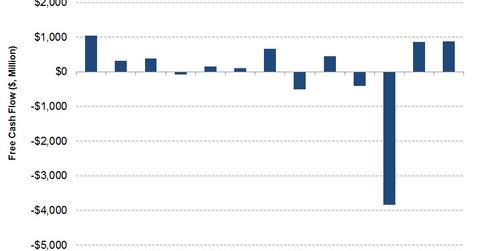Analyzing Halliburton’s Free Cash Flow and Capex Plan
In this article, we’ll analyze how Halliburton’s (HAL) operating cash flows have trended over the past few quarters. We’ll also discuss its free cash flow (or FCF).
March 16 2017, Updated 9:06 a.m. ET

Halliburton’s operating cash flows and capex
In this article, we’ll analyze how Halliburton’s (HAL) operating cash flows have trended over the past few quarters. We’ll also discuss how its free cash flow (or FCF) was affected given its capital expenditure (capex). FCF is cash flow from operating activities less capex.
Halliburton’s cash from operating activities (or CFO) rose ~20% in 4Q16 compared to 4Q15. HAL’s CFO was ~$1.1 billion in 4Q16. In 2Q16, HAL’s CFO was negative, mainly driven by a $3.5 billion termination fee paid to Baker Hughes in the quarter. Halliburton makes up 2.6% of the iShares North American Natural Resources ETF (IGE).
Halliburton’s free cash flow
HAL’s capex fell 60% from 4Q15 to 4Q16. Its lower capex coupled with the remarkable improvement in its CFO led to its higher cash flow in 4Q16.
In 4Q16, HAL’s FCF was $886 million, compared to $449 million a year earlier. Its most recent quarter’s FCF was also an improvement over 3Q16, when its FCF was $863 million. Halliburton’s FCF has been negative in four out of the past 13 quarters.
Peer comparison
Schlumberger’s (SLB) CFO was $2.0 billion in 4Q16. Weatherford International’s (WFT) CFO was $136 million, and Fairmount Santrol Holdings’ (FMSA) CFO was $8.5 million in the quarter.
Halliburton’s capex plans for 2017
In 2017, HAL plans to spend $1.0 billion in capex, 25% more than it spent in 2016. In 2017, HAL’s capex is expected to include the reactivation of cold stacked pressure pumping equipment and the conversion of its hydraulic fracturing fleet to the Q10 pumps required in shale fracturing. HAL plans to support its surface efficiency strategy by increasing its capex.
Next, we’ll discuss Halliburton’s dividends and dividend yields.
